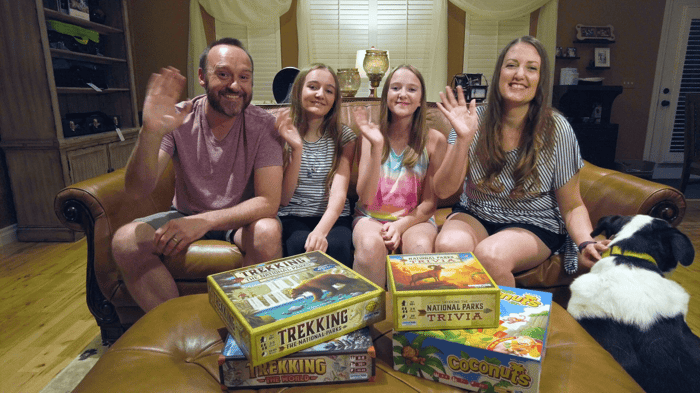You’ve made a game, and now you want to know how to get a board game published and share it with the world. Sound familiar?
I’ve been in these shoes myself. It’s both exciting and intimidating as you start to navigate the waters of the board game industry. It’s easy to get overwhelmed, confused, and even defeated as you try to figure out the next steps in publishing a game.
Over the years, many people have asked me for my tips and advice on getting a game out there. While I definitely don’t claim to be an expert in any way, I can speak to my experience of working in the board game industry and successfully publishing, Trekking the National Parks.
Of course, every game is different, and what works for one person may not work for another. But I hope this is helpful in understanding the industry and how to get a board game published. From my perspective, once you have a game you feel is ready to be published, you have three main paths to explore. These include pitching your game to publishers, print on demand, and Kickstarter. And I definitely wouldn’t start with or even recommend Kickstarter to most people—more on that later.
Option 1: Pitch Your Game to Publishers.
If you just love the art of designing games and you want to spend your time doing that above anything else, then you are a true game designer. You should pour all of your heart and energy into making the best games possible.
Don’t worry about coming up with the perfect theme or the exact marketing angle at first. Instead, spend your time making fun, quality games and testing them out with your friends. The good thing about this approach is that it’s relatively easy to put into practice. You don’t need a lot of materials or resources to create good games. Even just construction paper and homemade game pieces will help you get a prototype to the next level.
Once you’ve created your game, tested it, and really fine tuned it, the next step is to pitch it to publishers. This often takes place at conventions where you set up a time with individual publishers to pitch them. Some publishers will take ideas all the time, but you’ll have to do some digging and research to figure this out. (By the way, Underdog does not take unsolicited pitches at this time. We do recommend checking out resources on Cardboard Edison, though.)
For people who find this option appealing, there’s a good chance that the business side of making games doesn’t appeal to you. You’d rather spend your time and energy making games. Now there’s two important things to note for this option. First, it’s enormously important that you test a game thoroughly before you start pitching it. As designers, we need outside people beyond family and friends to test our games and give us honest feedback. It can take years to fine-tune a game until it’s ready.
Then the second thing to note is when you’re pitching your game to publishers, you need to be prepared for a lot of rejection and a lot of waiting. Always make sure you put your best foot forward with your game and your pitch, but go into it assuming you will never hear from or talk to these people again. Remember they likely get hundreds or even thousands of pitches every year, so they have to be highly selective about what makes it to the next level.
It can be disappointing to keep pitching a game and feel like you’re getting nowhere, but if your biggest goal is to design, keep going. Pitching one game won’t stop you from designing another. Keep making and creating great games.
Option 2: Print on Demand
For some, designing a game that never makes it to a physical product just isn’t enough. You want it to exist...to hold it...and for your family and friends to have it as well. Maybe there are even some outsiders who will buy it and play it, but with this option, your biggest goal isn’t to make a lot of money. It’s to make a game. This is where print on demand is a great option.
Now it’s still really important to take your time and make a quality product. Not only do you need to have good mechanics and spend time playtesting, but you also need to start thinking about art and design. It’s a bit of a debate in the industry as to whether you should have polished art and design when pitching to publishers. But with print on demand, it’s absolutely essential.
Many game designers who mostly focus on mechanics don’t think much about this. However, as you get ready to sell your game directly to consumers, you need to make sure you have a professional-looking product.
You can find several print-on-demand companies out there to help you, including The Game Crafter. With companies like this, you pretty much have everything you need to create a beautiful, quality game. If you have artistic abilities yourself, you might be able to put this together on your own. If not, you’ll probably want to invest in artwork and/or a graphic designer.
With print on demand, it’s best to assume you won’t necessarily make a profit on your game. I know this can be tough to hear because it’s always a “nice to have” to both create a game and have it be profitable. But the margins for print on demand are small, especially if you have a lot of components to your design. (Card games tend to be the most affordable for print on demand.)
While I generally only recommend print on demand for those who mostly want to create a game for themselves or family and friends, I do realize some people still use it to sell games. If this is you, then just make sure you’re doing everything possible to create a strong, quality game. Think of everything you possibly can to give your customer a good experience.
Is the text for the rules large enough? Did you test the rules out on regular people to make sure they’re not confusing? Is it unique or is there something similar already out there? Is it age appropriate for what you recommend on the box? These are just a handful of questions to be asking yourself along the way.
Option 3: Kickstarter
Kickstarter tends to be one of the first options people go to when they design a game and look at how to get a board game published, but I actually think it should be one of the last. Having been through a few Kickstarters now, both as an individual and as a company, I can tell you that it’s a ton of work.
If you’re going to do a Kickstarter, you are officially a company. This might seem fun, but there are a lot of responsibilities and business obligations that go along with this. This could clash with your dreams because you’re not just making a game anymore. You’re making a product. This often means you have to make some adjustments and compromises in order to be successful and even profitable.
We’ve all seen and read Kickstarter success stories where tabletop games have met and surpassed their goals, but the truth is that some of those games barely break even after you calculate the time involved, marketing expenses, and cost of making and shipping the game.
In addition, your game has to be undeniably good, from mechanics and rules to theme and presentation. Those who back games on Kickstarter know a good game when they see it, and you have just moments to appeal to potential backers. If the theme isn’t unique enough, the art isn’t good enough, or the game isn’t strong enough, your campaign could struggle.
We will be launching a new game, Trekking Through History, next year on Kickstarter, and we have an entire team of staff and freelancers who will be working to make it a success. I don’t want to dissuade you from looking at Kickstarter as a viable option, but it’s important to know what you’re getting yourself into. I believe in using Kickstarter to launch games and as a way to discover new companies and talents, but if you go down this road, you have to be a business person first.
Final Thoughts
I’ve been making games for more than 15 years, and let me assure you—not all my games have made it into a final product. In fact, some of my favorite ideas will probably never see the light of day for one reason or another.
Yet, I keep creating and making games, enjoying the process along the way as much as I can. For those of you who have made a game and are wondering what’s next, take it one step at a time. You might start out with one goal and then pivot to go in a different direction. This is OK. It might even make you a better creator or designer along the way. Good luck!





